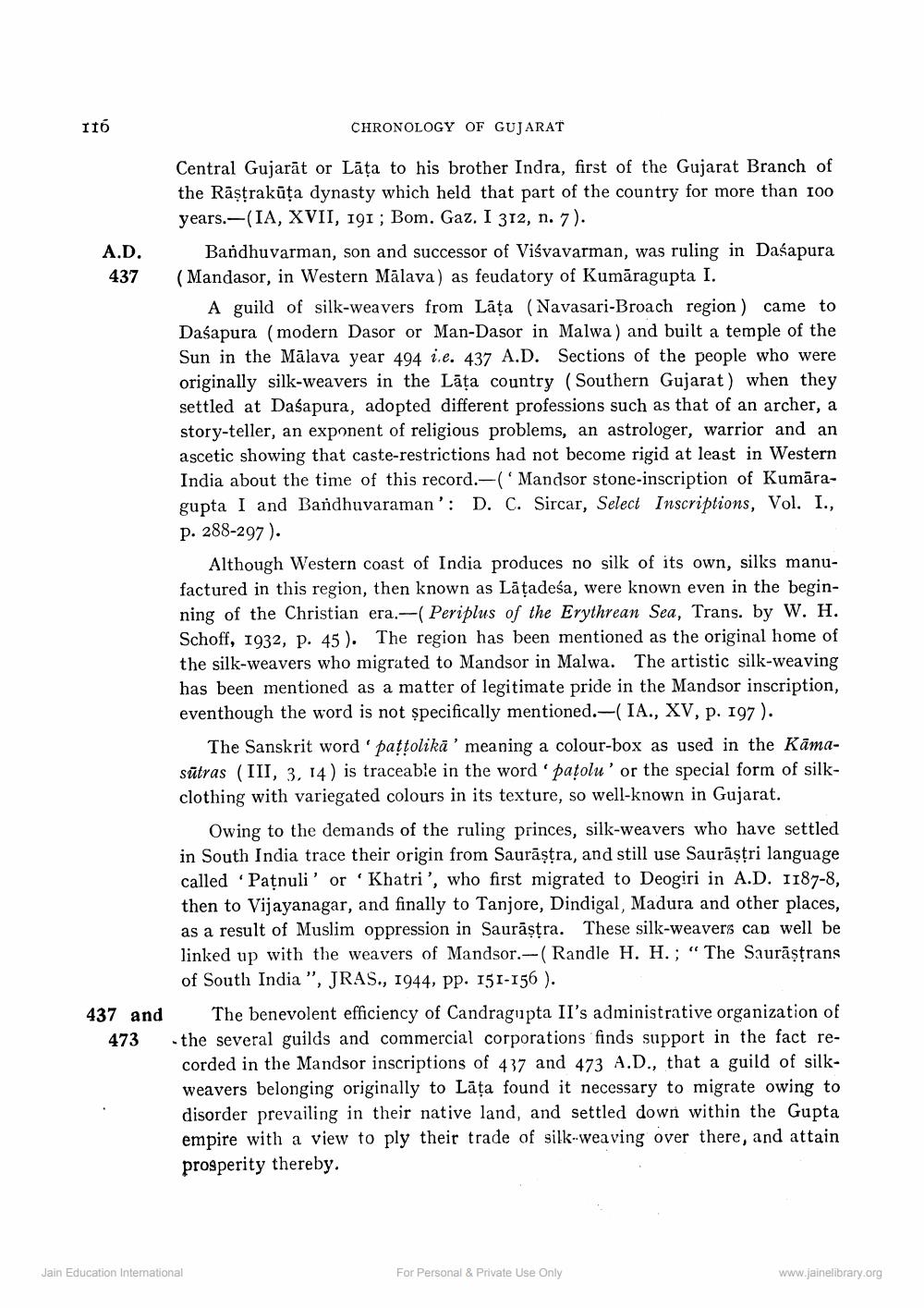________________
116
CHRONOLOGY OF GUJARAT
437
Central Gujarāt or Lāța to his brother Indra, first of the Gujarat Branch of the Rāstrakūța dynasty which held that part of the country for more than 100
years.-(IA, XVII, 191 ; Bom. Gaz. I 312, n. 7). A.D.
Bandhuvarman, son and successor of Viśvavarman, was ruling in Dasapura (Mandasor, in Western Mālava) as feudatory of Kumāragupta I.
A guild of silk-weavers from Lāța (Navasari-Broach region) came to Dasapura (modern Dasor or Man-Dasor in Malwa) and built a temple of the Sun in the Mālava year 494 i.e. 437 A.D. Sections of the people who were originally silk-weavers in the Lāța country (Southern Gujarat) when they settled at Daśapura, adopted different professions such as that of an archer, a story-teller, an exponent of religious problems, an astrologer, warrior and an ascetic showing that caste-restrictions had not become rigid at least in Western India about the time of this record.-(Mandsor stone-inscription of Kumāragupta I and Bandhuvaraman': D. C. Sircar, Select Inscriptions, Vol. I., p. 288-297).
Although Western coast of India produces no silk of its own, silks manufactured in this region, then known as Laţadeśa, were known even in the beginning of the Christian era.-( Periplus of the Erythrean Sea, Trans. by W. H. Schoff, 1932, p. 45). The region has been mentioned as the original home of the silk-weavers who migrated to Mandsor in Malwa. The artistic silk-weaving has been mentioned as a matter of legitimate pride in the Mandsor inscription, eventhough the word is not specifically mentioned.-(IA., XV, p. 197).
The Sanskrit word ' pattolikā' meaning a colour-box as used in the Kāmasūtras (III, 3, 14) is traceable in the word 'pațolu' or the special form of silkclothing with variegated colours in its texture, so well-known in Gujarat.
Owing to the demands of the ruling princes, silk-weavers who have settled in South India trace their origin from Saurāştra, and still use Saurāștri language called Pațnuli' or 'Khatri', who first migrated to Deogiri in A.D. 1187-8, then to Vijayanagar, and finally to Tanjore, Dindigal, Madura and other places, as a result of Muslim oppression in Saurāṣtra. These silk-weavers can well be linked up with the weavers of Mandsor.-(Randle H. H.; "The Saurāştrans
of South India ", JRAS., 1944, pp. 151-156 ). 437 and The benevolent efficiency of Candragupta II's administrative organization of 473 - the several guilds and commercial corporations finds support in the fact re
corded in the Mandsor inscriptions of 437 and 473 A.D., that a guild of silkweavers belonging originally to Lāța found it necessary to migrate owing to disorder prevailing in their native land, and settled down within the Gupta empire with a view to ply their trade of silk-weaving over there, and attain prosperity thereby.
Jain Education Interational
For Personal & Private Use Only
www.jainelibrary.org




